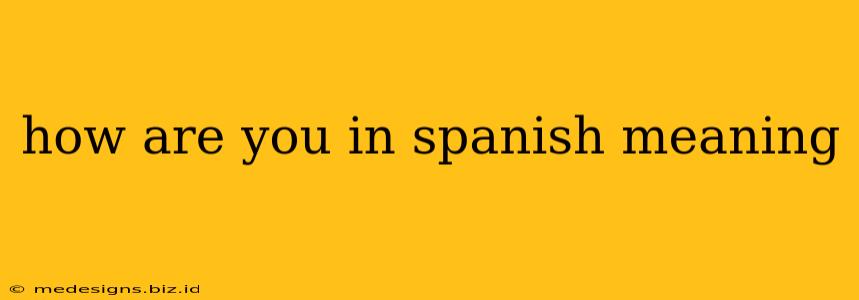"¿Cómo estás?" This simple phrase, known to even the most beginner Spanish learners, is the most common way to ask "How are you?" in Spanish. But the beauty of the Spanish language lies in its nuance. There are many ways to express this seemingly simple greeting, each carrying its own subtle implications and levels of formality. This guide explores the various ways to say "How are you?" in Spanish, helping you choose the perfect phrase for every situation.
Beyond "¿Cómo estás?": Exploring Different Ways to Ask "How Are You?"
While "¿Cómo estás?" is versatile, it's not the only option. The best choice depends on your relationship with the person you're addressing and the context of your conversation.
Formality Matters:
-
"¿Cómo está usted?" (Formal): This is the formal version, used when addressing elders, superiors, or people you don't know well. The use of "usted" (you formal) shows respect and politeness.
-
"¿Cómo estás tú?" (Informal): This is the informal version, suitable for friends, family, and people you're close to. The use of "tú" (you informal) reflects familiarity and closeness.
Adding Nuance:
The simple "¿Cómo estás?" can be enhanced to show deeper concern or interest. Here are some examples:
-
"¿Qué tal?" (How's it going?): This is a more casual and less formal way to ask "How are you?" It's suitable for everyday conversations with friends and acquaintances.
-
"¿Cómo te va?" (How's it going?): Similar to "¿Qué tal?", this phrase is informal and suitable for everyday conversations.
-
"¿Cómo anda?" (How's it going?): This is a more informal, even colloquial way to ask, common in some Spanish-speaking regions.
Beyond the Greeting: Showing Genuine Interest
A simple "How are you?" can sometimes feel perfunctory. To show genuine interest, you can add a follow-up question or comment:
-
"¿Cómo estás? ¿Qué has hecho hoy?" (How are you? What have you done today?): This shows a desire to know more about their day.
-
"¿Cómo estás? Espero que estés bien." (How are you? I hope you are well.): This adds a touch of warmth and concern.
Responding to "¿Cómo estás?" and its Variations
Knowing how to ask "How are you?" is only half the battle. Here are some common responses:
-
"Bien, gracias." (Fine, thank you.): This is the most common and polite response.
-
"Muy bien, gracias." (Very well, thank you.): This expresses even greater well-being.
-
"Regular." (So-so.): This is a suitable response if you're feeling neither great nor terrible.
-
"Mal." (Bad.): A straightforward response if you're having a difficult time. (Prepare for follow-up questions of concern!)
-
"Bastante bien." (Pretty good.): This shows a positive but not overly enthusiastic response.
Mastering the Nuances of Spanish Greetings
Learning to say "How are you?" in Spanish is more than just memorizing a few phrases. It's about understanding the cultural context and adapting your language to the situation. By using the appropriate level of formality and showing genuine interest, you can build stronger relationships and communicate more effectively with Spanish speakers. So, go ahead and practice! The more you use these phrases, the more natural and fluent your Spanish will become.
